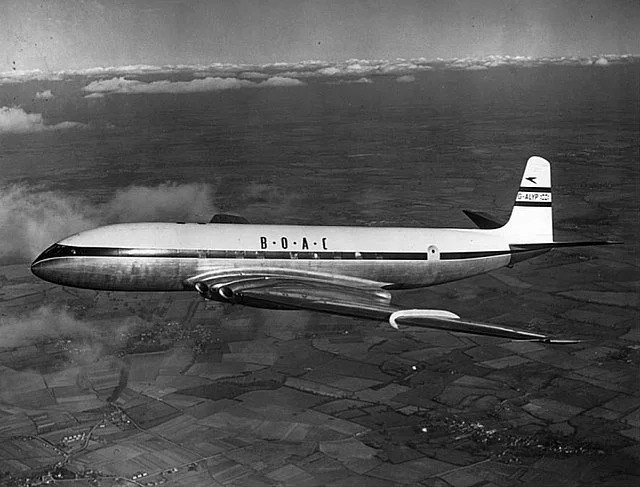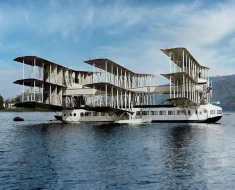A formal report was conducted after the mysterious disappearance of the British airliner Star Tiger in 1948 and concluded;
“It may truly be said that no more baffling problem has ever been presented for investigation.”
66 years before Malaysian Airlines flight MH370 hit the headlines around the world when it flew into oblivion, the vanishing of this British airliner led to similar questions: how could a modern (for 1948) airliner simply vanish, making no distress calls and leaving no trace? Was there something fundamentally wrong with the design of the Avro Tudor, or had something entirely unexpected overwhelmed this flight?
This is the story of what we know of the last flight of the Star Tiger.
Contents
- The Avro Tudor Airliner
- London to the Azores
- The Azores to Bermuda Route
- Final Flight
- What happened?
The Avro Tudor Airliner
To provide passenger transport, several British heavy bombers were hastily converted into make-shift airliners after World War Two. The Avro Lancastrian was little more than a Lancaster bomber with the gun turrets removed and the Handley Page HP 70 Halton was a similar conversion from a Halifax bomber.
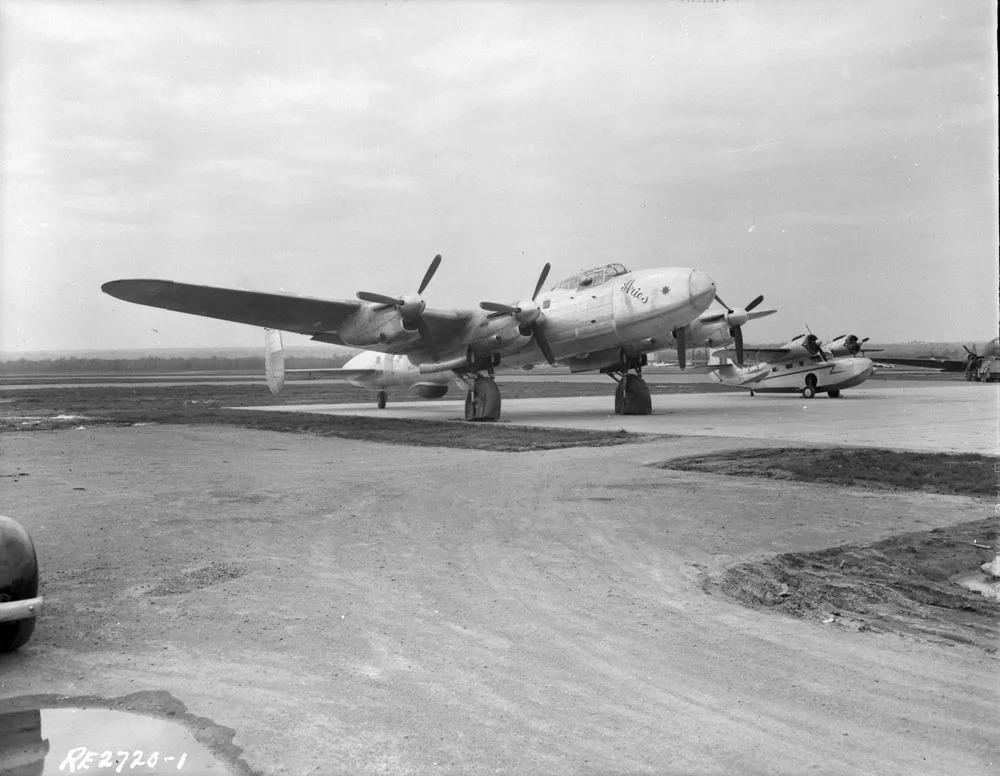
However, these converted bombers were cold, draughty and cramped. British airlines needed something better if they were to compete with the new airliners emerging from America. In 1943, Avro began work on the design of the Tudor, a new airliner that, while it used the wings and engines of the Avro Lincoln bomber, had a completely new tail section and fuselage. This, the first British airliner with a pressurised passenger cabin, first flew in June 1945.
Read More: Fw 200 Condor – The Airliner that went to War
British South American Airways (BSAA) was formed in early 1944 to provide an air alternative to shipping services to South America. Initially, BSAA used the Lancastrian airliner but in 1947 it took delivery of three Avro Tudors specifically modified to meet its needs. This aircraft, the Tudor IV, featured a lengthened fuselage capable of seating 32 passengers.
All aircraft operated by BSAA were given names that included the word “Star,” a reference to the celestial navigation used by these aircraft on long, overwater flights. The three Tudor IVs were named Star Lion, Star Panther and Star Tiger and all were delivered to BSAA in November 1947.
All BSAA Tudors were equipped with radio telegraphy equipment, with a range of thousands of miles, and radio telephony equipment, with a range of around 200 miles. Each was also provided with a Sperry autopilot and a radar altimeter effective up to 3,000 feet.
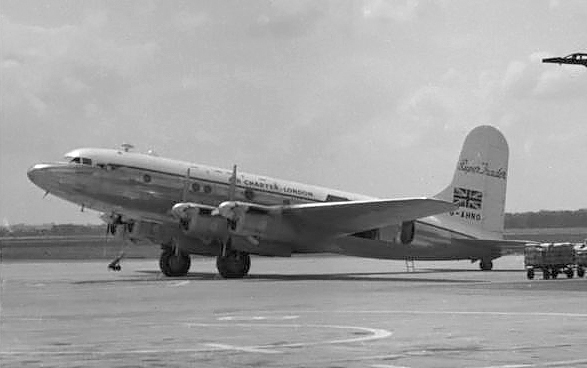
London to the Azores
On 27th January 1948 Star Tiger, a BSAA Avro Tudor IV, left London airport bound for Havana in Cuba. This aircraft had completed over 500 hours of flying time and had made eleven previous return flights from Britain to South America in the three months since it had been delivered to BSAA.
The captain for this flight was Brian McMillan, an experienced former RAF pilot. He was supported by a first and second officer and a radio operator. All members of the crew were very experienced and all had flown the London-Havana route before, though not as a single crew. Two “Star Girls”, female cabin attendants, were responsible for looking after the passengers.
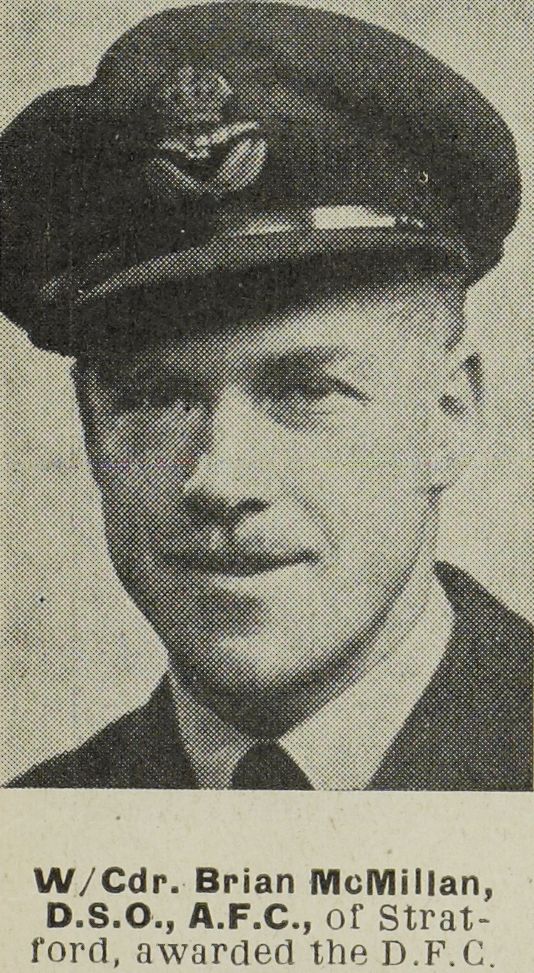
Compared to today’s high-speed jet travel, this was a marathon journey comprising four separate legs involving around 30 hours in the air. First, the aircraft would fly to Lisbon where it would refuel and make an overnight stop. The following day it would fly to Santa Maria in the Azores where it would make a short stop for refuelling. Then it would make the long flight to Kindley Field in Bermuda, then operated by the US Army Air Force.
The last leg of the flight would be a six-hour journey from Bermuda to Havana. When it left London the aircraft was carrying 23 passengers including retired RAF Air Marshall Sir Arthur Coningham.
The aircraft reached Lisbon on schedule, but it experienced problems during the flight with a compass and the cabin-heating system. The fuel-burning Janitrol heaters on the Tudor were notoriously unreliable and this failure not only led to extreme discomfort for passengers, but it also meant that the aircraft could not be flown at high altitudes, negating the advantages of having a pressurised cabin.
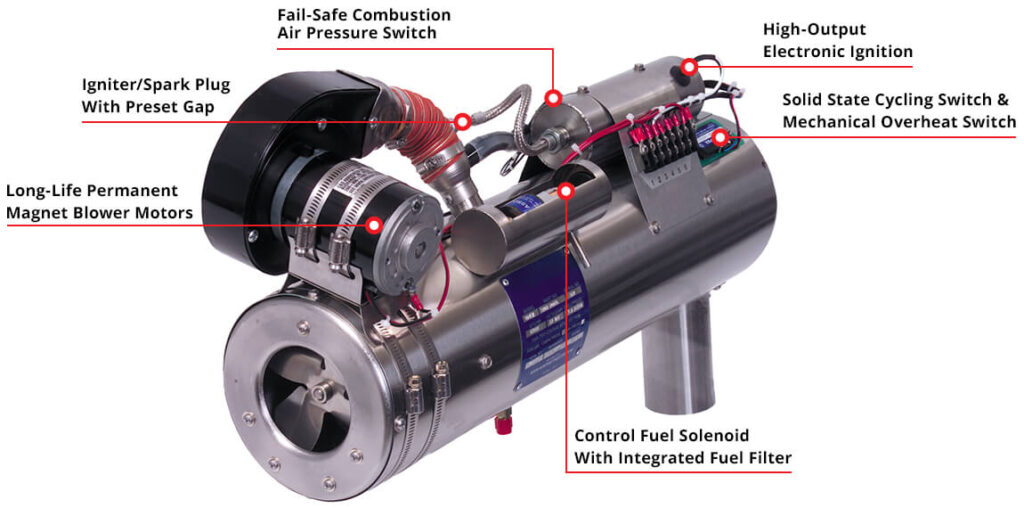
During the overnight stop in Lisbon, the compass was repaired and parts of the heating system were replaced (though it failed again early on the next leg of the journey). The flight was due to leave Lisbon at 09.15 on 28th January but it proved impossible to get the port inner engine started. A new fuel priming pump was fitted and the aircraft finally left Lisbon at 11.45 carrying two additional passengers.
After what must have been a very chilly and uncomfortable seven-hour flight, Star Tiger arrived at Santa Maria in the Azores later the same day. This was intended only to be a short stop to allow for refuelling, but due to late arrival and a forecast of bad weather ahead, Captain McMillan decided to remain in Santa Maria overnight and attempt the flight to Bermuda on the following day.
The Azores to Bermuda Route
The distance from the Azores to Bermuda is almost 2,000 miles. In 1948 this was one of the longest open-ocean routes flown by any airline in the world. With full tanks and in still air, the Avro Tudor carried sufficient fuel to fly 2,900 miles.
However, in January, an aircraft flying from the Azores to Bermuda could expect to encounter headwinds ranging on average from 20 to over 50 knots. Nevertheless, this should still have given Star Tiger a safety margin of around 2 hours of fuel remaining when it reached its destination.
The islands that comprise Bermuda are just 22 miles long and cover an area of less than 20 square miles. In terms of the vastness of the Atlantic Ocean, this is little more than a speck and these islands are almost 600 miles east of the nearest landfall in North America. Safely reaching Bermuda after crossing 2,000 miles of open ocean required very accurate navigation: the captain relied on frequent navigation position fixes to confirm the aircraft’s position.
Like all BSAA flights, the Star Tiger did not carry a dedicated navigator. Instead, the captain, first officer and second officer were all expected to act as navigators when they weren’t flying the aircraft. In these days when an instant GPS fix is never more than a click away, it’s worth pausing to consider the challenges facing the crew of the Star Tiger as they prepared for their flight to Bermuda.

There were two principal means of navigation available in the 1940s. Dead reckoning simply meant taking observations of features on the ground to confirm the aircraft’s position. However, between the Azores and Bermuda, there was not a single island or another landmark that could have been used so, on the flight of the Star Tiger, dead reckoning would have involved only estimates of wind drift taken by observing the surface of the sea and this was possible only during daylight.
The principal means of navigation was by celestial observation. The crew member acting as a navigator would use a sextant to take a fix on stars from the aircraft’s astrodome, located just behind the cockpit.
Read More: The Quest to Build a Flying Submarine
An experienced navigator (and the captain, first officer and second officer on this flight were all experienced navigators) could reliably fix the aircraft’s position to within 15 miles using this technique. However, this required the stars to be visible which is why most long over-water flights in this period took place at night.
When Star Tiger arrived at Santa Maria airport in the Azores, the crew discovered that another BSAA aircraft was already there, waiting for an improvement in the weather. This was a Lancastrian freight aircraft (G-AGWL) piloted by Captain Griffin and also bound for Bermuda. Captains McMillan and Griffin met on the morning of 29th January to discuss the flight to Bermuda. The strong headwinds were forecast to abate during the day at low altitudes, though they would remain strong at high altitudes.
It was therefore agreed that both aircraft would make the 12-hour flight at an altitude of just 2,000 feet. This was unusually low but it would avoid the strong headwinds at high altitudes and keep them below the forecast cloud base which would allow drift sightings to be taken during daylight. The Lancastrian was to take-off first and would broadcast weather and wind updates to Star Tiger, following around one hour behind.
Final Flight
Star Tiger was checked by ground staff at Santa Maria on the morning of 29th January. No significant faults were discovered (though the cabin heating system was still not working) and all the aircraft’s fuel tanks were filled. The BSAA Lancastrian took off from Santa Maria at 14:22 and Star Tiger followed at 15:34. The flight plan filed by the airliner estimated a flight time of 12 hours and 26 minutes, with arrival in Bermuda scheduled for 03:56 on 30th January.
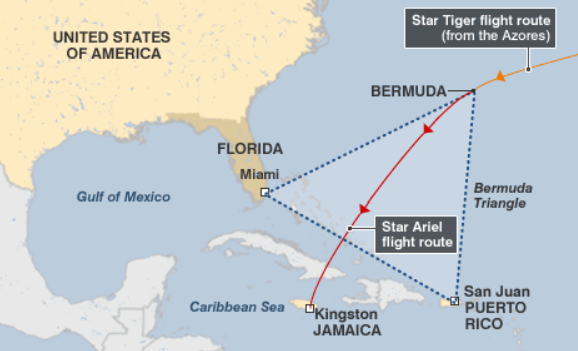
For almost the next 12 hours, Star Tiger exchanged information with the Lancastrian on weather and winds and broadcast regular updates on its estimated position, first via radiotelegraphy to the Azores, and then to the WT radio station in Bermuda, VRT.
The 02:00 position report noted that it had been possible to take an accurate celestial fix. This led to the discovery that the winds had changed direction, pushing the aircraft off course. As a result, in the 03:00 position report, Star Tiger amended its estimated time of arrival in Bermuda to 05:00. However, there was no suggestion of any concern or any technical problems.
At 03:04, Star Tiger requested a position fix from Bermuda. This involved the radio operator in the aircraft keeping the morse key depressed while the airport used its directional antenna to provide a bearing. This was not successful and the request was repeated by Star Tiger at 03:15. This time, VRT was able to give a bearing to the aircraft of 72˚. This was acknowledged at 03:17.
That was the last time that anyone heard from Star Tiger.
At 03:50, VRT contacted Star Tiger for a position update but received no reply. The operator wasn’t initially concerned, believing that the airliner might already have made radio contact with Bermuda Approach Control. At 04:11 the BSAA Lancastrian landed safely at Kindley Field. VRT tried again to contact Star Tiger at 04:40 but there was no reply and an emergency was declared.
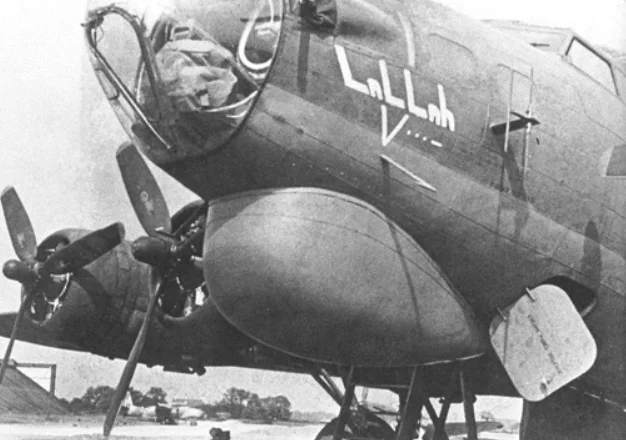
The first radar-equipped B-17 search aircraft left Kindley Field at 07:15 and for the next five days, an extensive air and sea search was carried out despite adverse weather. No trace of the Star Tiger or her six crew or 25 passengers was ever found.
What happened?
The loss of the Star Tiger and the absence of either wreckage or distress calls was so baffling that a formal Court of Enquiry was convened in Britain to look into this disappearance. The court presented a formal report to Parliament in September 1948. This concluded that there were no known faults or inherent problems with the Avro Tudor that might have caused it to break up in the air and no severe weather conditions in the area that might have led to sudden and catastrophic structural failure.
The report also considered several possible mechanical problems, ranging from the loss of an engine or propellor to the inadvertent release of one of the dinghies carried within the fuselage, but was able to suggest no scenario so sudden and complete that it would not have been possible for Star Tiger to broadcast a distress call.
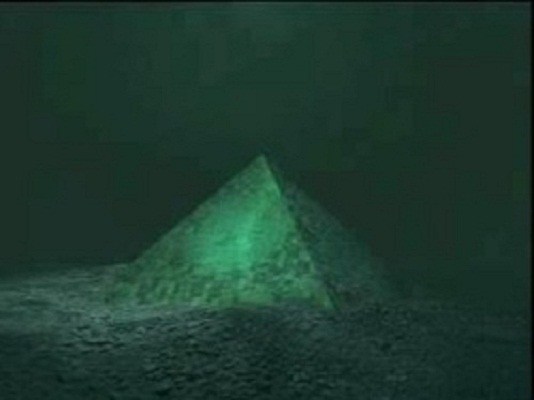
Running low on fuel was also ruled out for the same reason and even total electrical failure which might have disabled all radio equipment was considered. However, given that it had received an accurate position fix at 03:15 (at which time it must have been around 350 miles from Bermuda), and because a broken cloud in the area would have allowed the taking of a celestial position fix, it was thought unlikely that an electrical failure would have prevented the aircraft from reaching its destination. The report concluded:
“What happened in this case will never be known and the fate of “Star Tiger ” must remain an unsolved mystery.”
There was one tantalising clue: in all position reports broadcast during the flight to Bermuda, the Star Tiger gave her altitude as 20,000 feet. Clearly, this was an error: the flight plan specified 2,000 feet and, without cabin heating, flying in the frigid air at 20,000 feet would have been unbearable for the passengers. These consistent and careless errors in position reports are odd.
The radar altimeter with which the Tudor was equipped provided accurate readings up to 3,000 feet even in poor visibility. But is it possible that the crew of the Star Tiger simply forgot that they were flying so low and allowed the aircraft to descend until it smashed into the ocean?
Read More: North American X-10 – Unmanned Reusable Missile
One other possibility is an in-flight fire. The Janitrol cabin heater was located under the floorboards in the cockpit, beneath the co-pilot’s seat. The heater worked by bleeding fuel onto a heating tube but it was located close to hydraulic lines that also ran under the cockpit. Could explosive fumes have built up and been ignited by a spark? Could this then have caused a fire beneath the cockpit floor that went unnoticed until it compromised hydraulic lines and led to a sudden loss of control?
The truth is that we simply don’t know what happened to Star Tiger. All Avro Tudor airliners were immediately grounded after this incident and allowed to fly only freight operations. However, on the publication of the accident report which found no fundamental problems with the aircraft, it was allowed to resume passenger operations. Then, almost exactly one year later, another BSAA Avro Tudor airliner vanished in the same area in even more mysterious circumstances…
If you like this article, then please follow us on Facebook and Instagram.


